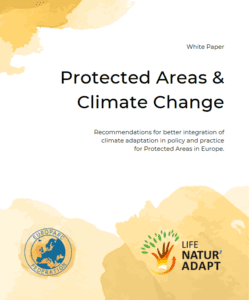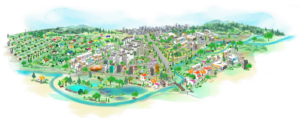Working together towards climate resilience – New White Paper!
The White Paper details four recommendations for better integration of climate adaptation in policy and practice for Protected Areas in Europe.
Necessary steps for climate change
The PROTECTED AREAS & CLIMATE CHANGE White Paper was developed in the framework of the LIFE Natur’Adapt project with the support of the EUROPARC Task Force on Climate Change. The project was a collective learning process on adaptation to climate change in Protected Areas. In Europe, Reserves Naturelles de France, EUROPARC and eight partners have come together to support the integration of climate change into Protected Area management practices.
The paper calls upon European decision-makers and national authorities to facilitate the co-design of integrated, long-term and large-scale environment management and spatial planning. It details the following recommendations:
1. Protected Areas should be adequately involved in climate action planning.
2. All Protected Areas across Europe, including Natura 2000 sites, should integrate Climate Adaptation planning.
3. Climate change adaptation and nature restoration planning should integrate rigorous participatory processes, engaging communities, public and private sectors.
4. Protected Areas designation process should aim at nurturing future-proof ecosystems.
Download the Protected Areas & Climate Change White Paper
Save the date!
Learn more about the recommendations for working together towards climate resilience. During the Online Seminar on 20 June 2023!
There, we will explore the results of the LIFE Natur’Adapt project, case studies from Protected Areas and current policy priorities and developments at regional and European levels.
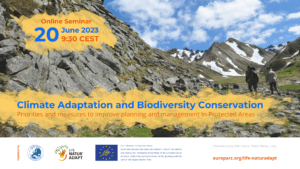

The LIFE Natur’Adapt project, as well as the Climate Change Taskforce, have received funding from the LIFE Programme of the European Union. Go to the official webpage of the project here.
Let’s green our cities! LIFE UrbanGreeningPlans leads the way
For two years, EUROPARC has been part of the LIFE UrbanGreeningPlans project that has tested innovative mechanisms and developed actions to plan, implement, strengthen, and manage green infrastructures in (peri-)urban areas. Now, the project has come to an end and a wealth of resources is available.
The LIFE UrbanGreeningPlans project has finalised after 2 years of intense work across 5 European cities and 2 NGOs. Through demonstrating and implementing innovative actions, sharing best practice case studies, and producing guidelines, the LIFE UrbanGreeningPlans project has paved the way for urban areas throughout Europe to include Green Infrastructure (GI), Nature-based Solutions (NbS) and the promotion of healthy ecosystems in their urban planning.
The different actions of the project build upon the wealth of experience from Europe’s Periuban Parks. The actions focussed around the central elements of Urban Greening Plans as indicated by the European Commission. These are:
![]()
Greening Plans Knowledge Hub
So, how to embark on the Urban Greening journey? To help cities start creating Urban Greening Plans, or take them to the next level, EUROPARC took on the task of creating a “Greening Plans Knowledge Hub” within the project. In this Knowledge Hub, you will find videos, podcasts, reports and much more to inspire you on how to enhance Biodiversity in your city or Periurban Park, and how to include Green Infrastructure (GI) and Nature-based Solutions (NbS) in urban plans.
Navigate the interactive map in search of resources by area type:
- Forests and semi-natural areas
- Agricultural areas
- Blue spaces
- Urban Green spaces
Or, use the topics indicated above to find the resources you are looking for!
This Knowledge Hub will be the long-lasting LIFE UrbanGreeningPlans project legacy.
It will be updated regularly. Are you working on this topic? Do you have anything to share? Please, fill in this form and we will upload your information in the hub.
Project recommendations
Furthermore, learnings from the project have resulted in the following set of recommendations for policymakers, planners, and managers to green our cities and set up Urban Greening Plans.
- URBAN GREENING PLANS NEED TO BECOME URGENT GREENING PLANS to adequately respond to Biodiversity loss and climate change.
- INCLUDE DIFFERENT SECTORS IN THE PLANNING PROCESS. Co-creating processes lead to better planned cities. By including different sectors and stakeholders in the planning process, more voices will be heard and acceptance will be higher.
- INCREASE GREEN SPACES through enlarging existing areas or purchasing new land to cool the city, increase biodiversity and give city dwellers more space for recreation.
- EXPAND THE WORKING AREA OF URBAN GARDENER BRIGADES to the outskirts of cities, also encompassing the periurban natural spaces.
- IMPROVE PRIVATE GARDENS IN CITIES; there is a huge potential to create more biodiverse private gardens through awareness-raising activities with citizens.
- INVOLVE CITIZENS IN MONITORING ACTIVITIES. It helps promote the importance of biodiversity and raises awareness of the public to biodiversity loss.
- RETHINK CURRENT INDICATORS TO IMPROVE BIODIVERSITY MONITORING. There is a need for a European index based on EU values regarding nature.
The EU Biodiversity Strategy 2030 calls upon cities with over 20.000 inhabitants to create Urban Greening Plans. These plans aim to bring nature back into cities to support biodiversity and mitigate climate change. This was the framework of the LIFE UrbanGreeningPlans project.

Strengthening links between biodiversity protection & human health and well-being
EUROPARC is part of the new Interreg Europe GREENHEALTH project that wants to strengthen links between biodiversity protection and human health and well-being. This week, the project had it’s kick-off meeting in Murcia.
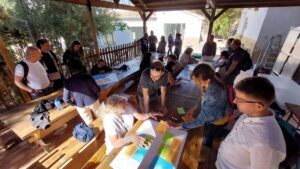
Group work during the Kick-off meeting. Photo by: Francisco Soriano, Region of Murcia at the courtyard of Las Alquerías, “Sierra Espuña” Regional Natural Park.
On the 9-10 May 2023, the partnership of Interreg Europe project, GREENHEALTH, “Sustainable Protected Areas as a key value for human well-being” met to kick-off the project in the marvellous setting of Sierra Espuña Regional Natural Park in the Murcia Region of Spain.
Interreg Europe GREENHEALTH intends to make EU regions more biodiversity resilient by improving the management of European Protected Areas through strengthening links between biodiversity protection and human health and well-being.
There is a demonstrated link between nature and human health and well-being. The health benefits of green and blue spaces are well documented for children, whose physical and mental development is enhanced by living, playing and learning in a green environment. Adults and elderly also benefit significantly from visiting green and blue spaces, through improved physical health and social well-being.
The GREENHEALTH project wants to create linkages between health and environmental policies and incorporating human health initiatives into Protected Area programmes.
This way, the project will be able to have strong impacts on the environmental as well as on the social side. How will it achieve these objectives?
- By revaluing Protected Areas, society will demand their conservation and more funds are allocated. This will have a positive impact on biodiversity.
- By transforming Protected Areas into natural health centres, GREENHEALTH can maximise the social benefits of Protected Areas for the persons living close to or visiting the Protected Areas.
- Project partners and their regional networks can build upon a decade of experience from the EUROPARC Federation’s Programme ‘Healthy Parks Healthy People Europe’.
The participants travelled from Croatia, Germany, Ireland, Poland, Slovakia, Spain and Sweden to meet in person.
Before getting down to the business of fine-tuning deadlines, methodology, and responsibilities to achieve GREENHEALTH’s goals in the coming 4 years (see the agenda here) the partners were welcomed by the Counsellor of Environment, Mar Menor, Universities and Research Juan María Vázquez and the Murcia´s Region General Director on Natural Environment María Cruz Ferreira Costa. Attendees also included key stakeholders from Poland, Slovakia, Spain and Sweden.
Representatives from each of the consortium partners attended the kick-off meeting, hosted by the project leader, Region of Murcia, Spain. GREENHEALTH partners are from seven regions and countries.
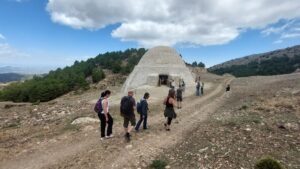
Field visit at Murcia Snow Wells Pozos de la Nieve, photo by Francisco Soriano, Region of Murcia
GREENHEALTH partners exhibit Interreg Europe’s inter-regional cooperation scheme due their geographical spread and diverse regional characteristics.
The GREENHEALTH project partners are:
- The Autonomous Community of the Region of Murcia. General Directorate of the Natural Environment, Spain – who is leading the project – link
- The Podkarpadkie Region, Poland – link
- The Public Institution for the management of protected natural areas of Dubrovnik-Neretva County, Croatia – link
- The Northern and Western Regional Assembly, Ireland – link
- The Prešov Self-Governing Region, Slovakia – link
- The Kullaberg Nature Reserve in Scania, Sweden – link
- EUROPARC Federation, (advisory partner) based in Germany
On day two of the meeting, the participants had the pleasure of visiting the Snow Wells visit: “Pozos de la Nieve” and to enjoy a special Murcia “forest therapy” experience.
GREENHEALTH´s next face-to-face meeting will take place in December 2023 in Croatia and hosted by the Dubrovnik-Neretva Administration.

